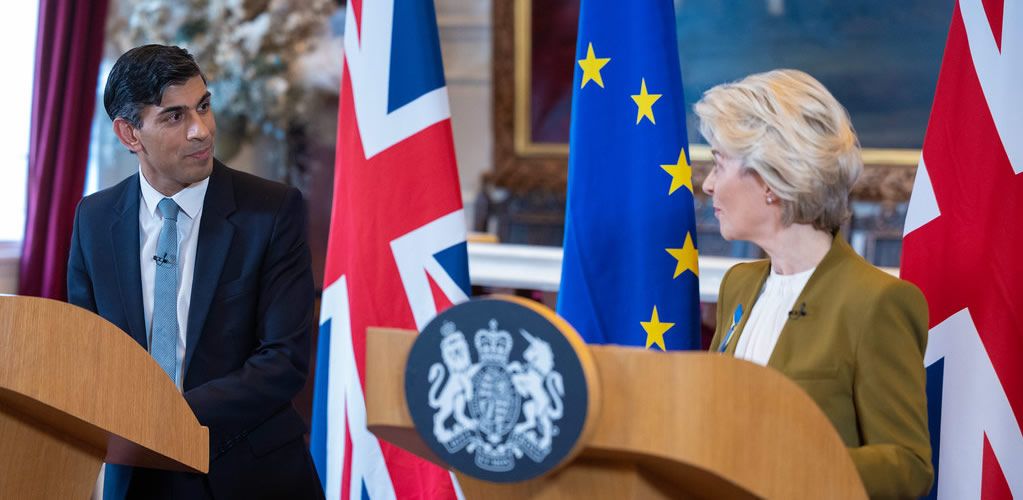Rishi Sunak’s Brexit deal: How the Stormont brake could block new EU laws from Northern Ireland
After years of negotiations, the EU and UK have finally agreed on a “Windsor Framework” to reduce trade barriers between Northern Ireland, Britain and the EU. But beware! There are strings attached, including a “Stormont Brake” for the NI Assembly to pull whenever they don’t like EU rules.

After years of negotiations, the EU and UK have finally agreed on a “Windsor Framework” to reduce trade barriers between Northern Ireland, Britain and the EU. But beware! There are strings attached, including a “Stormont Brake” for the NI Assembly to pull whenever they don’t like EU rules.
A fter years of tensions and negotiations, the EU and the UK have announced their proposed solution to the problem of trade barriers between Northern Ireland, Great Britain and the EU.
The Windsor framework is a political agreement which sets out amendments to the Ireland/Northern Ireland protocol. The protocol, a part of the EU-UK withdrawal agreement, was put in place to avoid border checks on goods traded between Northern Ireland and the Republic of Ireland. It did this by keeping Northern Ireland subject to EU customs and internal market law on goods.
But it has been highly contentious since its inception. Because Northern Ireland is subject to a separate regulatory and customs regime to the rest of the UK, goods entering from Great Britain are subject to checks. In addition to potential trade disruptions, the “Irish Sea border” is seen by some in the unionist community as an affront to their identity and place within the UK.
The Windsor framework does not get rid of the protocol but proposes to change it significantly. While barriers to trade between Great Britain and Northern Ireland are not removed entirely, the Windsor framework proposes reducing checks on goods not at risk of being sent on to the EU, as well as parcels, food products and pets. Crucially, medicines manufactured in Great Britain would no longer require EU authorisation to be lawfully placed in the Northern Ireland market.
The Irish Sea Border is still there, just less visible and less onerous for those involved in trade. But there are strings attached for the UK, including strict data sharing and labelling requirements, and putting in place reinforced surveillance and enforcement mechanisms.
The Stormont brake
Another key issue with the protocol has been that Northern Ireland remains subject to EU rules in which it has no say. Critics, in particular Northern Ireland’s Democratic Unionist Party (DUP), have argued that the protocol created a democratic deficit in Northern Ireland.
To address these concerns, the Windsor framework introduces a mechanism called the Stormont brake.
Currently, the protocol requires Northern Ireland to comply with a number of EU laws. It also allows for changes: if an EU act listed in the protocol is amended, replaced or deleted, this automatically also applies to the protocol.
The protocol’s content has therefore changed significantly since it came into force and is likely to continue changing in the future. This is a problem as it requires Northern Ireland to comply with evolving EU rules without having any input.
The Stormont brake seeks to rectify this democratic deficit by establishing a procedure allowing the Northern Ireland assembly to block the application of new EU rules in Northern Ireland.
The UK can apply a “brake”, within two months from the publication of an EU act, provided it has received a petition to do so from at least 30 members of the assembly representing at least two parties. The brake system incorporates a number of requirements and restrictions intended to avoid frivolous petitions.
Members must show that their petition for a rule to not apply is a measure of last resort and a matter of exceptional circumstance. They must also show that they carried out substantive prior consultations between the UK and the Northern Ireland executive, and sought to engage with the EU and other relevant parties before requesting to pull the brake.

PM Rishi Sunak welcomes the President of the European Commission Ursula von der Leyen to Windsor to discuss the Northern Ireland talks. | CREDIT: FLICKR/NUMBER 10
If the UK government accepts that these conditions have been met, the UK can notify the EU of its intention not to apply the rule in question. It is then up to the UK to assess whether to proceed.
The UK must provide the EU with a detailed account of how the rule differs significantly from whatever rule it is amending or replacing, and why this would significantly impact everyday life in Northern Ireland.
The Stormont brake attempts to strike a balance between Stormont having a greater influence on how EU law applies in Northern Ireland, and the need to avoid a scenario where the system is abused for political purposes. Whether the right balance has been struck is perhaps open to discussion, not least because the strict conditions might make it very difficult to use the system in practice.
Importantly, the Stormont brake relies on the restoration of power-sharing in Northern Ireland. This would require the DUP to end its boycott on power sharing, which it began as a protest against the Northern Ireland protocol.
For both the EU and the UK, the Windsor framework can be seen as a considerable achievement. If adopted, it should reduce barriers to trade while increasing the democratic legitimacy of rules applied in Northern Ireland.
Detractors will likely point to the things that the framework does not do. One point of complaint is the role of the European Court of Justice (ECJ). Under the protocol, the court has notable jurisdiction over the EU laws that apply in Northern Ireland. This has been considerably controversial, as the DUP wants the ECJ completely removed from Northern Ireland’s affairs.
But contrary to what some reports initially suggested, the framework does not affect the ECJ’s status under the protocol. Only the ECJ can rule on the validity and interpretation of EU law. Therefore, as long as EU law applies in Northern Ireland, the ECJ will remain a feature.
The UK government argues that by giving the UK a right to veto EU legislation, the brake system reduces the role of the ECJ under the protocol. In reality, while the right of veto could (if used) limit the EU law obligations under the protocol, the court’s jurisdiction remains the same as it is currently.
Some may also argue that the continued application of EU state aid law in the UK is a problem. And some may not be satisfied as long as EU law continues to apply – in any capacity – in Northern Ireland.
This should not detract from the significant efforts and concessions made to secure an agreement. Despite its potential weaknesses, the Windsor framework addresses many of the practical difficulties associated with the operation of the protocol, and could represent a compromise solution both sides can live with.

— AUTHOR —

|
▫ Dr Billy Melo Araujo, Senior Lecturer in EU and International Economic Law, Queen's University Belfast. |

|

|

|
Sources
▪ Text: This piece was originally published in The Conversation and re-published in PMP Magazine on 28 February 2023. | The author writes in a personal capacity.
▪ Cover: Flickr/Number 10. - Prime Minister Rishi Sunak holds a joint press conference with the President of the European Commission Ursula von der Leyen in Windsor Guildhall. | 27 February 2023. (Licensed under a Creative Commons Attribution-ShareAlike 4.0 International License.)







[Read our Comments Guidelines]